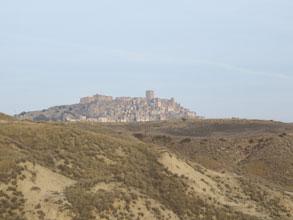 The town of Craco in southern Italy’s Basilicata region rises up from the gently rolling hills of the surrounding countryside. From a distance, the rugged stone walls of this now abandoned town blend seamlessly with the brownish green landscape, but the outline of its straight-edged buildings and the distinct, quadratic black holes, once windows, make it difficult for this town to go unnoticed by passersby. I happened to notice the town on a hot, September day on my way to Matera.
The town of Craco in southern Italy’s Basilicata region rises up from the gently rolling hills of the surrounding countryside. From a distance, the rugged stone walls of this now abandoned town blend seamlessly with the brownish green landscape, but the outline of its straight-edged buildings and the distinct, quadratic black holes, once windows, make it difficult for this town to go unnoticed by passersby. I happened to notice the town on a hot, September day on my way to Matera.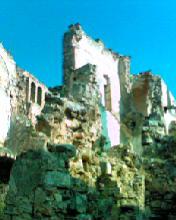 Warning signs at the edge of the town forbid unauthorized entrance to the buildings. And if that’s not enough to stop people, perhaps the wall of debris –crumbling old bricks, stones and sharp ceramic roof tiles- might deter them from exploring the dangerous ruins that lie beyond. Despite the warning signs, my curiosity got the better of me and I carefully climbed over the debris. I found myself in the cellar of what used to be someone’s house. I made my way up the steep, uneven staircase, all the while thinking that I should turn back before the building collapses.
Warning signs at the edge of the town forbid unauthorized entrance to the buildings. And if that’s not enough to stop people, perhaps the wall of debris –crumbling old bricks, stones and sharp ceramic roof tiles- might deter them from exploring the dangerous ruins that lie beyond. Despite the warning signs, my curiosity got the better of me and I carefully climbed over the debris. I found myself in the cellar of what used to be someone’s house. I made my way up the steep, uneven staircase, all the while thinking that I should turn back before the building collapses.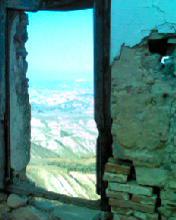 Upstairs, there was no furniture and the floors were noticeably clear of debris, which is rather odd since there was no roof overhead. The brilliant sunlight coming in through the roof made the pastel pink, yellow and blue coloured walls of each room seem brilliant, almost too bright to look at without my sunglasses. The far wall of the main room had a gaping crack starting from the top corner and narrowing down to the floor. Beyond the crack was nothing but air, just a view of the endless soft rolling hills in the distance. I felt as though I was inside a Salvador Dali painting. Everything seemed distorted and out of proportion -unreal, to say the least. I didn’t dare step too close to the edge.
Upstairs, there was no furniture and the floors were noticeably clear of debris, which is rather odd since there was no roof overhead. The brilliant sunlight coming in through the roof made the pastel pink, yellow and blue coloured walls of each room seem brilliant, almost too bright to look at without my sunglasses. The far wall of the main room had a gaping crack starting from the top corner and narrowing down to the floor. Beyond the crack was nothing but air, just a view of the endless soft rolling hills in the distance. I felt as though I was inside a Salvador Dali painting. Everything seemed distorted and out of proportion -unreal, to say the least. I didn’t dare step too close to the edge. 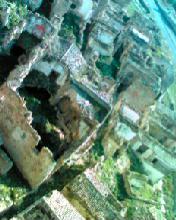 I stepped out of the house onto a slightly overgrown cobblestone road. I wandered through town, snapping photos and imagining the town's people going about their daily activities. When I reached the centre of the town, I was surprised to see that it was in quite good condition. It was a little rough around the edges but it resembled a modern southern Italian town. Most of the buildings were intact, with roofs and doors, some even had furniture. One can only come to the conclusion that the former residents left in a hurry, facing certain danger. I later learned that Craco was built on unstable ground, over sink holes which began to swallow up the town in 1961. The town suffered severe landslides, causing progressive abandon by residents.
I stepped out of the house onto a slightly overgrown cobblestone road. I wandered through town, snapping photos and imagining the town's people going about their daily activities. When I reached the centre of the town, I was surprised to see that it was in quite good condition. It was a little rough around the edges but it resembled a modern southern Italian town. Most of the buildings were intact, with roofs and doors, some even had furniture. One can only come to the conclusion that the former residents left in a hurry, facing certain danger. I later learned that Craco was built on unstable ground, over sink holes which began to swallow up the town in 1961. The town suffered severe landslides, causing progressive abandon by residents. 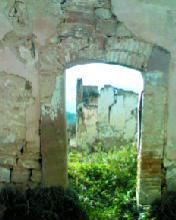 The town of Craco has a rich history. It was originally built for military purposes during medieval times and later developed into a typical southern Italian town, albeit, with its own unique character and charm. Descendents of the town, many of whom now live in the United States, have developed the Craco Society, dedicated to preserving the culture, traditions and history of Craco. They have a website and held the first annual Craschesi del Nord America Reunion in August 2007. For further information about Craco, visit http://www.thecracosociety.org/ .
The town of Craco has a rich history. It was originally built for military purposes during medieval times and later developed into a typical southern Italian town, albeit, with its own unique character and charm. Descendents of the town, many of whom now live in the United States, have developed the Craco Society, dedicated to preserving the culture, traditions and history of Craco. They have a website and held the first annual Craschesi del Nord America Reunion in August 2007. For further information about Craco, visit http://www.thecracosociety.org/ .

